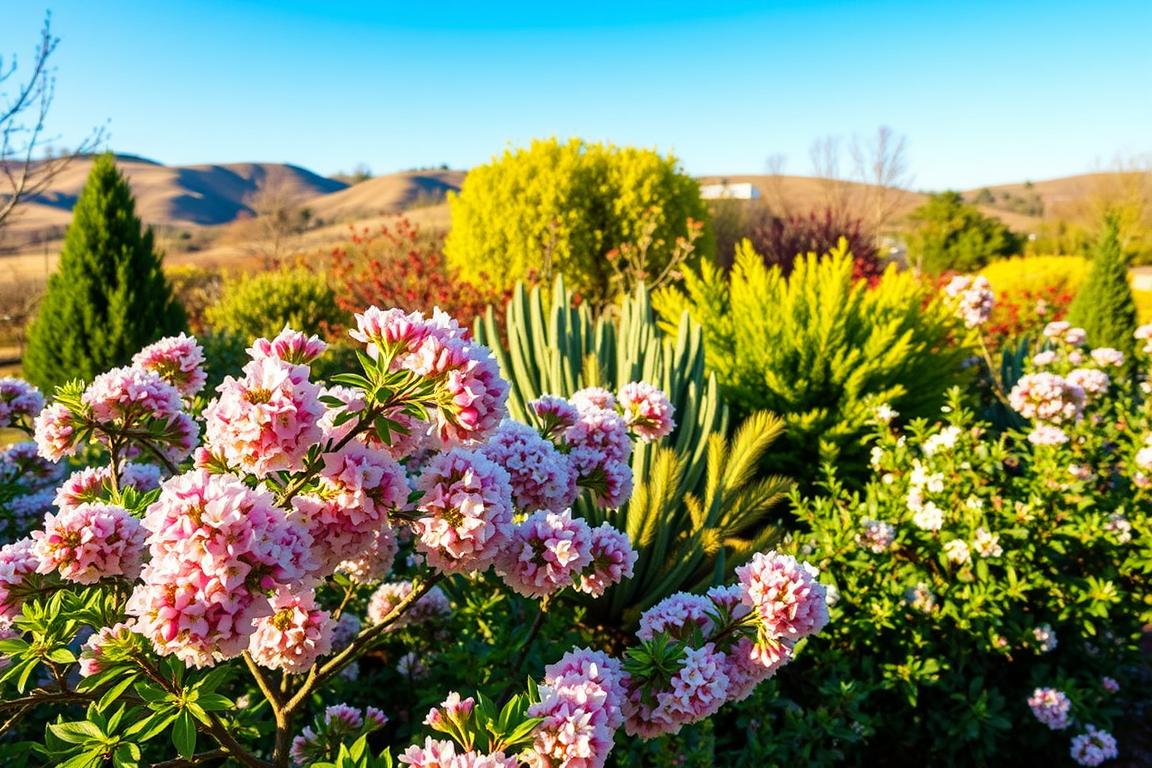Winter’s cold is fading, and gardeners can’t wait for spring. It’s the perfect time to plant flowering shrubs. They will soon fill your garden with color and life.
Choosing the right flowering shrubs can be tough. This article will help you pick the best ones. Your garden will then become a beautiful and lively place.
Key Takeaways
- Discover the best flowering shrubs for spring.
- Learn how to choose the right shrubs for your garden.
- Find out which spring flowering shrubs are low maintenance.
- Get tips on planting and caring for your new shrubs.
- Explore the top recommendations for vibrant garden displays.
Why Spring is the Perfect Time for Planting Flowering Shrubs
Spring is the best time to plant flowering shrubs because of its mild weather. The soil is moist and the temperatures are just right. This lets new shrubs grow well before summer gets too hot.
This season is great for spring garden shrubs. It lets them start growing early and bloom more.
Some benefits of planting in spring include:
- Healthy root development
- A wide variety of popular spring shrubs available in nurseries
- Optimal establishment before summer
Gardeners can also enjoy the ease of buying from nurseries and garden centers. They offer contact-free orders and parking lot pickups. This makes it simple to find the perfect springtime shrubs for gardens. Planting in spring means your garden will be full of color.
How to Choose the Right Flowering Shrubs for Your Garden
Creating a lively garden starts with picking the right flowering shrubs. You need to think about a few key things. First, know your garden’s special conditions. Then, pick shrubs that love those conditions.
Consider Your USDA Hardiness Zone
Start by looking at your USDA Hardiness Zone. This tells you which shrubs will do well in your climate. It ensures your shrubs can handle your area’s cold winters.
Assess Your Garden's Sunlight Conditions
Then, figure out how much sun your garden gets. This helps pick shrubs that love the light you have. Whether it’s lots of sun, some shade, or full shade, there’s a shrub for it.
Evaluate Your Soil Type and Drainage
Last, check your soil type and drainage. This is key to picking shrubs that will do great in your soil. Some shrubs need well-drained soil, while others like it wet.
| Shrub Type | Sunlight Requirement | Soil Preference |
|---|---|---|
| ‘Sunshine Blue’ | Full Sun | Well-drained |
| Lilac | Full Sun | Well-drained |
| Azalea | Partial Shade | Acidic, Well-drained |
Top10 Flowering Shrubs to Plant This Spring
Spring is here, and it’s the perfect time to pick and plant the best flowering shrubs. These shrubs can turn your garden into a colorful oasis. They attract pollinators and make your outdoor space more beautiful.
1. Hydrangea
Hydrangeas are loved by gardeners for their stunning flowers and versatility. They have big, showy blooms in pink, blue, and white.
Appearance and Bloom Colors
Hydrangeas come in bigleaf, panicle, or smooth varieties. Each has unique bloom colors and shapes. The color of the blooms depends on the soil pH, with acidic soils making them blue and alkaline soils making them pink.
Growing Requirements
Hydrangeas need well-draining soil and partial shade to full sun, depending on the type. They need regular watering, more so in hot summer months.
Planting and Care Tips
When planting hydrangeas, make sure the soil is rich in organic matter. Mulching around the base helps keep moisture in and weeds out. Prune them in late winter or early spring to keep their shape and encourage new growth.
2. Lilac
Lilacs are cherished for their fragrant, purple blooms that signal spring’s arrival. They are easy to care for and can grow well in many conditions.
Appearance and Bloom Colors
Lilacs have a conical or pyramidal shape and vibrant purple flowers. Some varieties have white or pink blooms.
Growing Requirements
Lilacs prefer full sun and well-draining soil. They are drought-tolerant once established but do best with regular watering.
Planting and Care Tips
Plant lilacs in a spot with good air circulation to prevent disease. Prune them right after they bloom to keep their shape and encourage new growth.
3. Azalea
Azaleas are a favorite for their vibrant, often fragrant blooms that cover the shrubs in spring. They come in a variety of colors, including pink, purple, and white.
Appearance and Bloom Colors
Azaleas have funnel-shaped flowers and evergreen or deciduous foliage. Bloom colors vary widely among varieties.
Growing Requirements
Azaleas thrive in acidic, well-draining soil and partial shade. They need consistent moisture, more so during dry spells.
Planting and Care Tips
When planting azaleas, use acidic potting mix and mulch around the base to retain moisture. Fertilize after blooming to promote healthy growth.
4. Forsythia
Forsythia is one of the first shrubs to bloom in spring, producing bright yellow flowers that herald the season’s arrival.
Appearance and Bloom Colors
Forsythias are known for their vibrant yellow blooms that cover the branches before leaves emerge.
Growing Requirements
Forsythias prefer full sun and well-draining soil. They are relatively low maintenance and can tolerate a range of soil conditions.
Planting and Care Tips
Prune forsythias immediately after they finish blooming to maintain shape and encourage new growth. This shrub can be used as a hedge or specimen plant.
5. Rhododendron
Rhododendrons are prized for their large, showy blooms and evergreen foliage, making them a staple in many gardens.
Appearance and Bloom Colors
Rhododendrons produce large, bell-shaped flowers in shades of pink, purple, and white.
Growing Requirements
Rhododendrons require acidic, well-draining soil and partial shade. Consistent moisture is crucial, more so during dry periods.
Planting and Care Tips
Plant rhododendrons in a location protected from extreme winds and frost. Mulch around the base to retain moisture and regulate soil temperature.
6. Weigela
Weigela is a flowering shrub that attracts hummingbirds and butterflies with its tubular flowers.
Appearance and Bloom Colors
Weigela produces funnel-shaped flowers in shades of pink, red, and white.
Growing Requirements
Weigela prefers well-draining soil and full sun to partial shade. It is relatively drought-tolerant but performs best with regular watering.
Planting and Care Tips
Prune weigela in late winter or early spring to maintain shape and promote new growth. Fertilize after blooming to encourage more flowers.
7. Viburnum
Viburnum is a versatile shrub known for its clusters of white or pink flowers and attractive foliage.
Appearance and Bloom Colors
Viburnums produce clusters of small flowers, often followed by berries that attract birds.
Growing Requirements
Viburnums prefer well-draining soil and full sun to partial shade. They are relatively low maintenance and can tolerate a range of conditions.
Planting and Care Tips
Plant viburnums in a location with good air circulation to prevent disease. Prune as needed to maintain shape.
8. Butterfly Bush
Butterfly Bush is a favorite among gardeners for its long, conical flowers that attract butterflies and other pollinators.
Appearance and Bloom Colors
Butterfly Bush produces flowers in shades of purple, pink, and white, often with a fragrant scent.
Growing Requirements
Butterfly Bush prefers well-draining soil and full sun. It is relatively drought-tolerant but performs best with regular watering.
Planting and Care Tips
Prune Butterfly Bush in early spring to promote new growth and encourage more blooms. It can be invasive in some areas, so monitor its spread.
9. Rose of Sharon
Rose of Sharon is a late-summer bloomer that produces large, showy flowers in shades of pink, purple, and white.
Appearance and Bloom Colors
Rose of Sharon is known for its hibiscus-like flowers that bloom in late summer, providing a late-season display.
Growing Requirements
Rose of Sharon prefers well-draining soil and full sun. It is relatively low maintenance and can tolerate a range of soil conditions.
Planting and Care Tips
Prune Rose of Sharon in late winter or early spring to maintain shape and promote new growth. It can be trained as a shrub or small tree.
10. Spirea
Spirea is a versatile shrub known for its clusters of small flowers and attractive foliage.
Appearance and Bloom Colors
Spireas produce clusters of small flowers in shades of pink and white, often followed by attractive seed heads.
Growing Requirements
Spireas prefer well-draining soil and full sun. They are relatively low maintenance and can tolerate a range of conditions.
Planting and Care Tips
Prune spireas in late winter or early spring to maintain shape and promote new growth. Some varieties can be invasive, so monitor their spread.
When choosing flowering shrubs for your garden, think about bloom time, growth habits, and maintenance needs. This will help you create a stunning and easy-to-care-for landscape.
| Shrub Name | Bloom Color | Growing Conditions | Maintenance Level |
|---|---|---|---|
| Hydrangea | Pink, Blue, White | Partial Shade, Well-draining Soil | Medium |
| Lilac | Purple, White, Pink | Full Sun, Well-draining Soil | Low |
| Azalea | Pink, Purple, White | Partial Shade, Acidic Soil | Medium |
| Forsythia | Yellow | Full Sun, Well-draining Soil | Low |
| Rhododendron | Pink, Purple, White | Partial Shade, Acidic Soil | Medium |

Essential Planting Tips for Spring Flowering Shrubs
To make sure your spring-flowering shrubs do well, follow some key planting tips. Planting them right will help them grow and bloom better.
Proper Hole Preparation and Spacing
Start by digging a hole that’s two to three times wider than the shrub’s root ball. Make it just as deep. This lets the roots spread out and grow easily. Proper spacing is also key; space them based on their mature size to avoid overcrowding.
Watering Guidelines for Newly Planted Shrubs
Water your new shrubs often, but not too much, during their first year. Keep the soil moist but not soggy. Water deeply once or twice a week, depending on the weather. Consistent moisture is good for strong roots.
Mulching Techniques for Moisture Retention
Mulching helps keep the soil moist, stops weeds, and keeps the temperature right. Use 2-3 inches of organic mulch like wood chips or bark around the plant. Keep it a few inches from the trunk. This simple trick can really boost your shrubs’ health.
| Planting Tip | Description | Benefit |
|---|---|---|
| Proper Hole Preparation | Dig a hole 2-3 times as wide as the root ball | Encourages root spread and establishment |
| Adequate Spacing | Space shrubs according to their mature size | Prevents overcrowding and promotes healthy growth |
| Regular Watering | Water deeply once or twice a week | Maintains soil moisture and supports root development |
| Mulching | Apply 2-3 inches of organic mulch around the base | Retains moisture, suppresses weeds, and regulates soil temperature |

Caring for Your Flowering Shrubs Throughout the Seasons
Caring for flowering shrubs is a year-round job. You need different strategies for each season. This ensures your shrubs stay healthy, bloom well, and add beauty to your garden.
Spring Care and Fertilization
In spring, give your shrubs a balanced fertilizer. This helps them grow and bloom. For hydrangeas, adjust the soil pH to change bloom colors. Use aluminum sulfate for blue blooms and lime for pink.
Summer Maintenance and Deadheading
In summer, keep your shrubs looking good by deadheading. This means removing spent blooms to encourage more flowers. Prune lightly after blooming to keep their shape and encourage new growth.
Fall Preparation and Cleanup
In fall, get your shrubs ready for winter. Clean up leaves and debris to prevent disease. This also helps them grow well in spring.
Winter Protection Strategies
Keep your shrubs safe from harsh winter weather. Apply mulch around the base. This keeps moisture in and helps control soil temperature.
| Season | Care Activity | Benefit |
|---|---|---|
| Spring | Fertilization | Promotes healthy growth and blooming |
| Summer | Deadheading and Pruning | Encourages more blooms and maintains shape |
| Fall | Cleanup | Prevents disease and promotes healthy growth |
| Winter | Mulching | Protects roots from harsh conditions |
Combining Flowering Shrubs for Maximum Visual Impact
Flowering shrubs can make your garden stunning when paired right. By picking the best combinations, you can boost your garden’s beauty. This creates a lively and engaging landscape.
Creating Layered Plantings with Various Heights
To make your garden more interesting, use shrubs of different heights. This method adds depth and makes your garden feel more dimensional. For example, tall shrubs like Hydrangea or Lilac can be the backdrop. Shorter shrubs, like Deutzia (such as Yuki Snowflake® and Yuki Cherry Blossom®), can be in the front.
Color Coordination Strategies for Stunning Displays
Choosing the right colors is key for a beautiful display. Pick shrubs with colors that go well together. For a soft, romantic look, pair pink and white blooms.
Bloom Time Succession Planning for Continuous Color
To keep your garden colorful all season, plan your blooms. Choose shrubs that bloom at different times. For example, Forsythia blooms early, followed by Rhododendron and Azalea later. This way, your garden stays vibrant and colorful longer.
Common Problems and Solutions for Spring Flowering Shrubs
Spring flowering shrubs can face many issues, even with good care. These problems include pests, diseases, and issues with growth or blooming.
Identifying and Managing Common Pests
Pests like aphids, spider mites, and scale can harm flowering shrubs. To fight these pests, gardeners can use insecticidal soap or neem oil. It’s important to check the shrubs often for pests.
Preventing and Treating Fungal Diseases
Fungal diseases, such as powdery mildew and leaf spot, are a big worry. To stop these diseases, make sure plants have good air flow and don’t get water on their leaves. If a disease does show up, fungicides can help. Also, get rid of any sick leaves or branches.
Addressing Growth and Blooming Issues
Shrubs might not grow or bloom right due to many reasons. These include bad pruning, not enough nutrients, and stress. To fix these problems, gardeners should prune correctly and use the right fertilizers. For example, Loropetalum ‘Cerise Charm’ needs little pruning to stay healthy. Knowing what each shrub needs is crucial.
Conclusion
Spring is a great time to update your garden with colorful shrubs. These plants bring life and color to your outdoor space. They make your garden look amazing all season long.
Choosing the right shrubs for spring can attract pollinators and add beauty. They help create a layered look and match colors. This way, your garden blooms beautifully at different times.
By following the tips in this article, you can have a stunning garden in the spring. Whether you want to add a few plants or redo your whole garden, the right shrubs are key. They can transform your outdoor space.
FAQ
What are the best flowering shrubs to plant in the spring?
Top picks for spring include Hydrangea, Lilac, and Azalea. Forsythia, Rhododendron, and Weigela are also great. Viburnum, Butterfly Bush, Rose of Sharon, and Spirea round out the list. These shrubs offer vibrant blooms and thrive in many conditions.
How do I choose the right flowering shrubs for my garden?
First, check your USDA Hardiness Zone. Then, look at your garden’s sunlight and soil. This helps pick shrubs that fit your local climate and garden conditions.
What are the benefits of planting flowering shrubs in the spring?
Spring planting gives shrubs a head start on summer. The mild weather and moist soil help them grow strong. This leads to more blooms.
How do I care for my flowering shrubs throughout the year?
Spring needs fertilization, summer pruning, and fall cleanup. Winter protection is also key. These steps keep your shrubs healthy and blooming.
What are some common problems that can affect flowering shrubs, and how can I address them?
Pests, diseases, and growth issues can trouble shrubs. Spot problems early and act fast. Use organic pest control or adjust your care routine.
How can I combine flowering shrubs to create a visually appealing garden?
Mix shrubs of different heights and colors for stunning displays. Plan for continuous color by choosing varieties that bloom at different times.
What are some popular spring flowering shrubs that are easy to care for?
Forsythia, Lilac, and Azalea are easy to care for. They bloom brightly and need little maintenance.
How do I plant flowering shrubs correctly?
Start by preparing the planting hole well. Space shrubs right and water and mulch effectively. This helps them grow strong and thrive.







